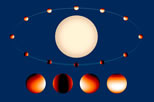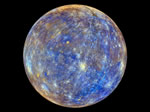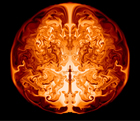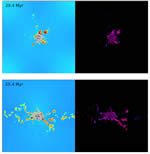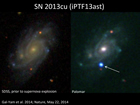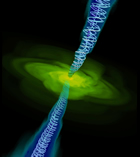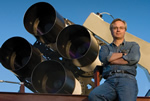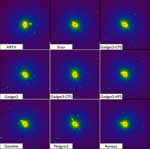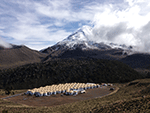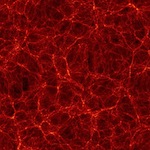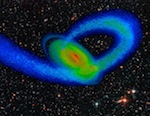Word doc
PDF (formatted and ready to go as a single newsletter page)
Without a Trace—Almost
It was a classic case of serendipity.
While investigating how supermassive black holes formed in the early universe, UC Santa Cruz postdoctoral researcher Ke-Jung Chen stumbled on the unanticipated discovery that some primordial supermassive stars could explode without leaving any black hole or other stellar remnant behind.
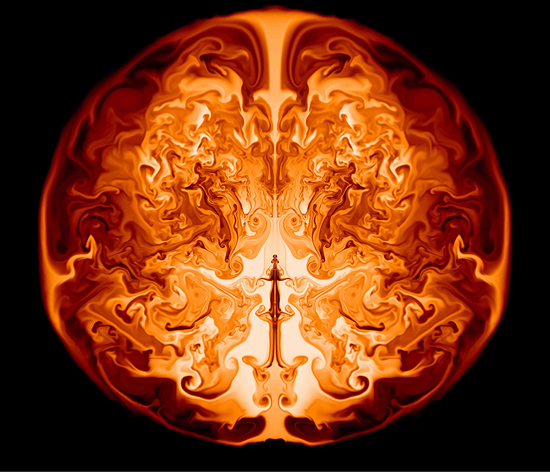
This image is a slice through the interior of a supermassive star of 55,500 solar masses along the axis of symmetry. It shows the inner helium core in which nuclear burning is converting helium to oxygen, powering various fluid instabilities (swirling lines). This snapshot shows a moment one day after the onset of the explosion, when the radius of the outer circle would be slightly larger than that of the orbit of the Earth around the sun.
Credit: Ken Chen, UC Santa Cruz
Chen had been fascinated by supermassive black holes since grad school at the University of Minnesota. Every big galaxy has one of these voracious monsters at its center: a black hole millions or even billions of times more massive than the sun.
The big mystery long puzzling astrophysicists is: how did supermassive black holes form? The ones that exist at the centers of some very ancient galaxies that shine brightly as quasars formed when the universe was less than 800 million years old. But no ordinary-sized stellar-mass black holes could have grown that gigantic that fast.
So the conclusion seemed inescapable: supermassive black holes had to have started life already monstrous at cosmic dawn. But how?
Monster stars
Just as ordinary black holes are the stellar remnants left by supernova explosions of stars more than 20 solar masses, supermassive black holes could have originated from supernova explosions of supermassive stars—ones having tens of thousands of solar masses.
Today, the highest-mass stars top out at about 100 solar masses (Eta Carinae, one of the most massive stars in our Milky Way galaxy, is about 90). But recent cosmological simulations suggest the possibility that in the early universe truly gargantuan stars could exist. So Chen began exploring this with two different computational simulations, called KEPLER and CASTRO, using resources at the National Energy Research Scientific Computing center (NERSC) at Lawrence Berkeley National Laboratory.
KEPLER is 1-dimensional (meaning it assumes that stars are spherical, so physical quantities such as temperature or density can depend only on radius). KEPLER follows how gas turns into stars and how supernovae feed back energy into surrounding gas; it also traces how convection—movement of gas inside a star—affects mixing and nuclear burning. CASTRO allows more complexity: it recreates a multidimensional section through a star, modeling internal gravitational forces and tracking the masses of specific atomic elements that are synthesized from nuclear fusion.
Most importantly, both simulations were run at high spatial resolution to explore fine details of an explosion. The supermassive star Chen modeled had a radius of about 103 million miles—about 10% larger than Earth’s orbit—with a resolution of 30,000 miles, only 0.03% of the radius.
Live fast, die young…leave no corpse
The simulations revealed that a supermassive star burns hydrogen at a furious rate for under 2 million years—a mere blink of a cosmic eye (the Sun is about 5 billion years old) before beginning to collapse. Then what happens internally depends critically on its mass. If it is less than 55,000 or more than 56,000 solar masses, the supermassive star explodes and leaves behind a supermassive black hole.
But if it is between those masses—say, 55,500 solar masses—special processes in the star’s ultrahot low-density core trigger a general relativity instability that triggers an explosion so violent that it “completely unbinds the star and leaves no compact remnant,” write Chen and his five coauthors in Astrophysical Journal. Indeed, the explosion “at ~9 x 1054 erg is the most energetic thermonuclear SN [super-nova] known.”
Okay, that’s what the simulations predict. Did such exotic primordial explosions happen in the real Universe? Future wide-field infrared telescopes in orbit—such as the proposed Wide Field InfraRed Survey Telescope (WFIRST)—might be able to directly detect such explosions at the very edge of the universe a few hundred million years after the Big Bang.
Moreover, the volume of “metals”—chemical elements heavier than helium—that a general-relativity–instability supernova explosion (GSNe) expels into space would be 100 times greater than that from a regular supernova. But it would have a different chemical composition, consisting only of lighter elements from carbon to silicon rather than heavier ones such as iron. “Traces of GSNe might therefore be found in early galaxies that are 56Fe [iron] deficient but enhanced with 12C [carbon] and 16O [oxygen],” Chen and his coauthors conclude.
Stay tuned! – Trudy E. Bell, M.A.
Further reading: The paper “The General Relativistic Instability Supernova of a Supermassive Population III Star” in the August 1, 2014 issue of Astrophysical Journal by Ke-Jung Chen et al is at http://iopscience.iop.org/0004-637X/790/2/162/. See also the press release “Simulations Reveal Unusual Death for Ancient Stars” at http://www.nersc.gov/news-publications/news/science-news/2014/simulations-reveal-unusual-death-for-ancient-stars/ and http://news.ucsc.edu/2014/09/unusual-supernova.html, and the Astrobites story “A New Way to Die: What Happens to Supermassive Stars?” at http://astrobites.org/2014/03/21/a-new-way-to-die-what-happens-to-supermassive-stars/.
The University of California High-Performance AstroComputing Center (UC-HIPACC), based at the University of California, Santa Cruz, is a consortium of nine University of California campuses and three Department of Energy laboratories (Lawrence Berkeley Laboratory, Lawrence Livermore Laboratory, and Los Alamos National Laboratory). UC-HiPACC fosters collaborations among researchers at the various sites by offering travel and other grants, co-sponsoring conferences, and drawing attention to the world-class resources for computational astronomy within the University of California system. More information appears at http://hipacc.ucsc.edu .
